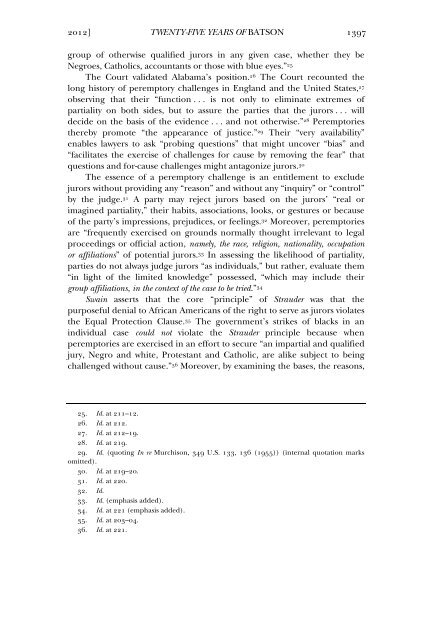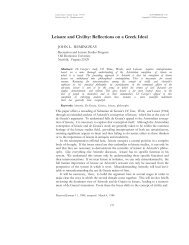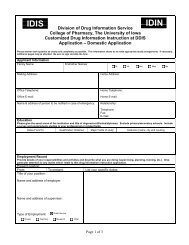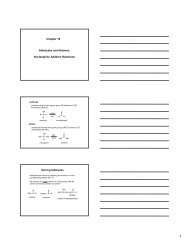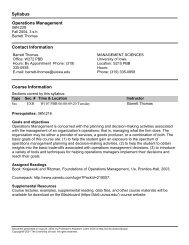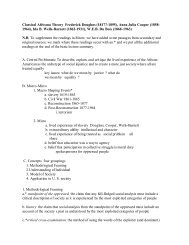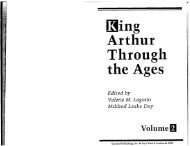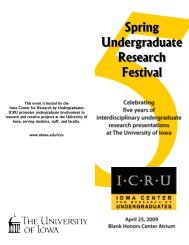Twenty-Five Years of Batson: An Introduction to ... - University of Iowa
Twenty-Five Years of Batson: An Introduction to ... - University of Iowa
Twenty-Five Years of Batson: An Introduction to ... - University of Iowa
Create successful ePaper yourself
Turn your PDF publications into a flip-book with our unique Google optimized e-Paper software.
2012] TWENTY-FIVE YEARS OF BATSON 1397<br />
group <strong>of</strong> otherwise qualified jurors in any given case, whether they be<br />
Negroes, Catholics, accountants or those with blue eyes.” 25<br />
The Court validated Alabama’s position. 26 The Court recounted the<br />
long his<strong>to</strong>ry <strong>of</strong> peremp<strong>to</strong>ry challenges in England and the United States, 27<br />
observing that their “function . . . is not only <strong>to</strong> eliminate extremes <strong>of</strong><br />
partiality on both sides, but <strong>to</strong> assure the parties that the jurors . . . will<br />
decide on the basis <strong>of</strong> the evidence . . . and not otherwise.” 28 Peremp<strong>to</strong>ries<br />
thereby promote “the appearance <strong>of</strong> justice.” 29 Their “very availability”<br />
enables lawyers <strong>to</strong> ask “probing questions” that might uncover “bias” and<br />
“facilitates the exercise <strong>of</strong> challenges for cause by removing the fear” that<br />
questions and for-cause challenges might antagonize jurors. 30<br />
The essence <strong>of</strong> a peremp<strong>to</strong>ry challenge is an entitlement <strong>to</strong> exclude<br />
jurors without providing any “reason” and without any “inquiry” or “control”<br />
by the judge. 31 A party may reject jurors based on the jurors’ “real or<br />
imagined partiality,” their habits, associations, looks, or gestures or because<br />
<strong>of</strong> the party’s impressions, prejudices, or feelings. 32 Moreover, peremp<strong>to</strong>ries<br />
are “frequently exercised on grounds normally thought irrelevant <strong>to</strong> legal<br />
proceedings or <strong>of</strong>ficial action, namely, the race, religion, nationality, occupation<br />
or affiliations” <strong>of</strong> potential jurors. 33 In assessing the likelihood <strong>of</strong> partiality,<br />
parties do not always judge jurors “as individuals,” but rather, evaluate them<br />
“in light <strong>of</strong> the limited knowledge” possessed, “which may include their<br />
group affiliations, in the context <strong>of</strong> the case <strong>to</strong> be tried.” 34<br />
Swain asserts that the core “principle” <strong>of</strong> Strauder was that the<br />
purposeful denial <strong>to</strong> African Americans <strong>of</strong> the right <strong>to</strong> serve as jurors violates<br />
the Equal Protection Clause. 35 The government’s strikes <strong>of</strong> blacks in an<br />
individual case could not violate the Strauder principle because when<br />
peremp<strong>to</strong>ries are exercised in an effort <strong>to</strong> secure “an impartial and qualified<br />
jury, Negro and white, Protestant and Catholic, are alike subject <strong>to</strong> being<br />
challenged without cause.” 36 Moreover, by examining the bases, the reasons,<br />
25. Id. at 211–12.<br />
26. Id. at 212.<br />
27. Id. at 212–19.<br />
28. Id. at 219.<br />
29. Id. (quoting In re Murchison, 349 U.S. 133, 136 (1955)) (internal quotation marks<br />
omitted).<br />
30. Id. at 219–20.<br />
31. Id. at 220.<br />
32. Id.<br />
33. Id. (emphasis added).<br />
34. Id. at 221 (emphasis added).<br />
35. Id. at 203–04.<br />
36. Id. at 221.


